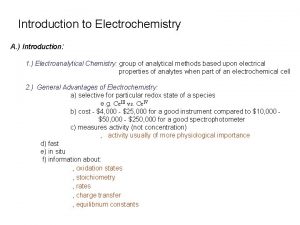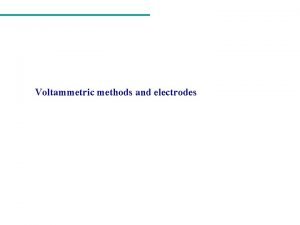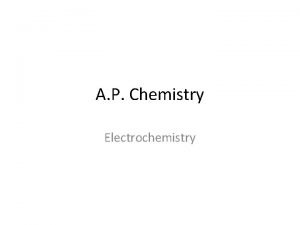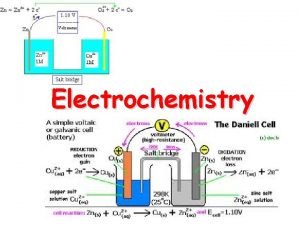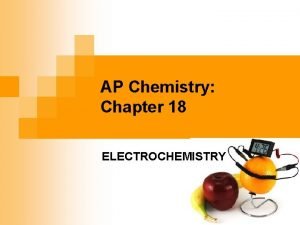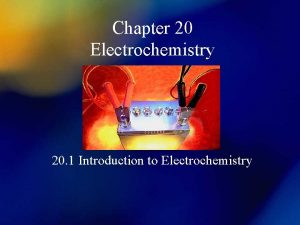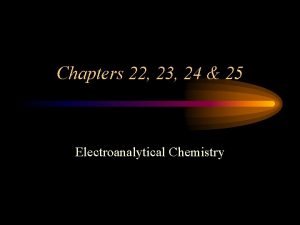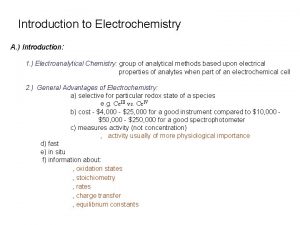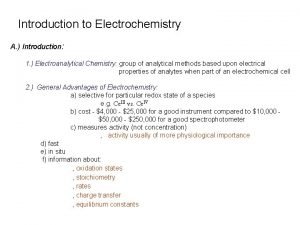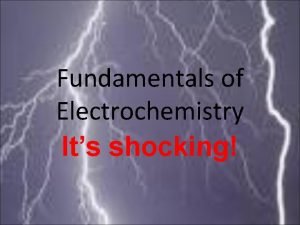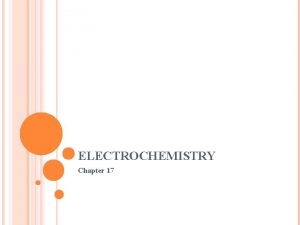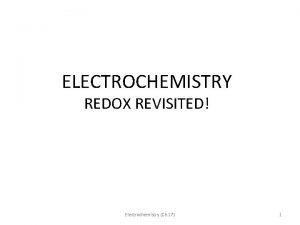An Introduction to Electroanalytical Chemistry Electrochemistry The study









- Slides: 9

An Introduction to Electroanalytical Chemistry Electrochemistry: The study of the interchange of chemical and electrical energy Oxidation is the loss of electrons (Increase in charge). Reduction is the gain of electrons (Decrease in charge) Electrochemical Cells: 1. Galvanic Cells: Produces electrical current spontaneous chemical reactions Battery Cu 2+ + Zn Cu 2+ + 2 e- Cu E 0 = +0. 34 V Zn 2+ + 2 e- Zn E 0 = − 0. 76 V Cu + Zn 2+ E 0 = 0. 34 – (-0. 76) = 1. 10 V 2. Electrolytic Cells Consumes electrical current Zn 2+ + Cu Zn + Cu 2+ non-spontaneous and require external e-source (DC power source) E 0 = - 1. 10 V

Parts of the voltaic or galvanic cell… Anode the electrode where oxidation occurs After a period of time, the anode may appear to become smaller as it falls into solution. Cathode the anode where reduction occurs After a period of time it may appear larger, due to ions from solution plating onto it. Salt Bridge a device used to maintain electrical neutrality in a galvanic cell This may be filled with agar which contains a neutral salt or it may be replaced with a porous cup. Electron Flow always from anode to cathode (through the wire)

Anode Cathode

The diagram to the right illustrates what really happens when a Galvanic cell is constructed from zinc sulfate and copper (II) sulfate using the respective metals as electrodes.

Electrolytic cells Electrolysis of molten sodium chloride None spontaneous reaction converted to spontaneous reaction Electrical energy converted into chemical energy Conduction in Electrochemical cells: a. External connection Movement of electrons through the external wire. b. Within the solution migration of cations and anions c. At the electrode surface Oxidation/Reduction reaction

A simplified drawing of a membrane cell for the production of Na. OH and Cl 2 gas from a saturated, aqueous solution of Na. Cl (brine).

Electrolysis from aqueous solution Consider electrolysis of aqueous Na. Cl. The process become complex in the presence of water as the water itself can be oxidized or reduced. Cathode – H 2 is released Anode – O 2 is released for dilute Na. Cl Cl 2 is released for conc. Na. Cl Experimental results Cathode : 2 competing reactions 2 H 2 O + 2 e → H 2 + 2 OHNa+ + e → Na + OHH 2 O with higher red. potential is reduced. Anode : 2 competing reactions 2 H 2 O → O 2 + 4 H+ 2 Cl- → Cl 2+ 2 e + 4 e Eo = -0. 83 V Eo = -2. 71 V Eo= -1. 23 V Eo= -1. 36 V The oxidation pot for H 20 is a little higher and since the conc of Cl- is low H 2 O is oxidized. However, if high conc. Of is used Na. Cl, due to the concentration effect Cl- is oxidized.

Cathodes and Anodes Cathode of an electrochemical cell is the electrode at which reduction occurs Anode of an electrochemical cell is the electrode at which oxidation

Standard Cell Notation (line notation) • Conventions: Anode on Left Single line : represent phase boundaries Two line : represent liquid junction e- V e- Zn Zn 2+ Cu Cu 2+ NO 3 - Anode / anode solution // cathode solution / Cathode Example: Zn / Zn 2+ (1. 0 M) // Cu 2+ (1. 0 M) / Cu
 Electroanalytical chemistry definition
Electroanalytical chemistry definition Interfacial method in electrochemistry
Interfacial method in electrochemistry Ap chemistry chapter 18 electrochemistry test
Ap chemistry chapter 18 electrochemistry test Danielle cell
Danielle cell What is electrochemistry in chemistry
What is electrochemistry in chemistry What is electrochemistry in chemistry
What is electrochemistry in chemistry Ap chemistry ced
Ap chemistry ced Chapter 20 review electrochemistry
Chapter 20 review electrochemistry Ib organic chemistry
Ib organic chemistry Inorganic vs organic chemistry
Inorganic vs organic chemistry
